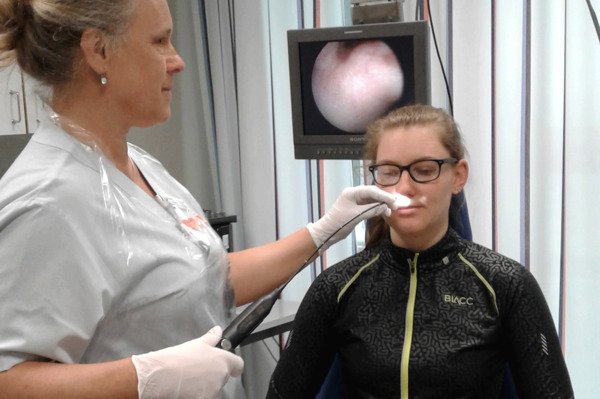Eating and Swallowing Disorders

Swallowing disorders (dysphagia) are prevalent in neurological disorders (incl stroke), where the neurological control of the swallowing deviates from what is normal. Dysphagia is also common in other health conditions, such as COPD (Chronic Obstructive Pulmonary Disease) and head and neck cancer. Frail elderly with several health conditions and cognitive decline form a large group with complex health care needs related to their dysphagia.
Risks of dysphagia include insufficient intake of fluids and nutrition, and saliva, drinks and food entering the airways which can lead to pneumonia and choking. Social limitations and a reduced quality of life are common. Taken together, dysphagia is a serious health problem.
Early detection and intervention of dysphagia are important to minimize complications. In several projects we investigate dysphagia prevalence, and construct or try out new assessment instruments. Intervention projects include evaluation of effects on swallowing of “contagious yawning” and expiratory muscle strength training (EMST)
Project group members
| Name | Title | Function |
|---|---|---|
| Kerstin Johansson | PhD, Lecturer | Project group leader |
| Per Östberg | Assoc. prof, PhD | Researcher |
| Riita Möller | Ass. prof, ENT, phoniatrician | Researcher |
| Sanna Jansson | SLP | Master student |
| Emma Lindroos | SLP | Master student |
| Jeanette Tellford | SLP | Master student |
| Maria Kjellholm | SLP | Co-worker |
| Kerstin Gustafsson | SLP | Co-worker |
In collaboration with
| Name | Title | Function | Lärosäte |
|---|---|---|---|
| Lena Hartelius | Professor, SLP | Researcher | Institute of Neuroscience and Physiology, Department of Health and Rehabilitation, Sahlgrenska academy, Göteborgs University |
| Mats Trulsson | Professor | Researcher | Department of odontology, Karolinska Institutet |
| Katrien Colman | PhD, Docent | Researcher | Hanze Hogeschool, Groeningen, Netherlands |
| Camilla Andersson | Head of development | Collaborator | Ersta Diakoni, Ersta social work |
Research projects
- Prevalence of dysphagia in individuals 65 years and over who visit a primary health care central (Maria Kjellholm & Kerstin Johansson)
- EAT-10 (Riitta Möller, Kerstin Johansson, Per Östberg)
- Design of a multilevel screening tool to detect mealtime problems in older people with dementia in the community or residing in nursing homes (Katrien Colman & Kerstin Johansson)
- Effects of free water in patients with dysphagia (Sanna Holstein Jansson)
- Free from dysphagia? (Emma Lindroos)
- Effects of contagious yawning on saliva production and swallowing in adults with traumatic brain injury – a possible treatment method (Jeanette Telford)
Selected publications
Deery, S. Dysphagia: a review of diagnostic screening tools & their use in nursing homes for the elderly. Student report, Summer research school, Karolinska Institutet, 2017
Persson, E., Wårdh, I., & Östberg, P. (2018). Repetitive Saliva Swallowing Test: Norms, Clinical Relevance and the Impact of Saliva Secretion. Dysphagia, 1-8
Möller R, Safa S, Östberg P. Validation of the Swedish translation of Eating Assessment Tool (S-EAT-10). Acta Oto-Laryngologica, 2016;136(7):749-53
Vogel AP, Keage MJ, Johansson K, Schalling E. Treatment for dysphagia (swallowing difficulties) in hereditary ataxia. Cochrane Database Syst Rev. 2015 Nov 13;11:CD010169
